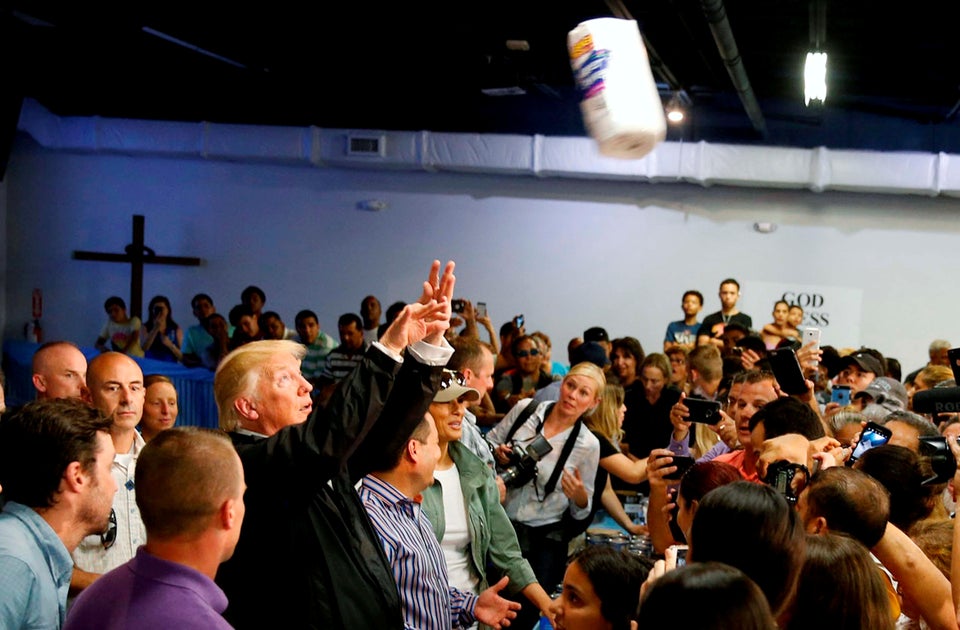It’s hard to define 2017 in a few words. Some might call the last year a turning point or a culmination of bottled feelings, but one thing we can agree on is that 2017 was a wild ride with some of the craziest news cycles in recent history.
President Donald Trump’s administration began on Jan. 20, and with the new White House came a maelstrom of polarization in the United States. Americans confronted some uncomfortable truths about society this year, including deep-rooted racism and sexism.
While the country was facing cultural upheaval, it also was hit by horrific tragedies. People came together to deal with natural disaster after natural disaster, in an unyielding season of hurricanes and fires. And, yet again, America suffered through another year of gun violence.
So pour yourself a heaping cup of covfefe, make sure your eclipse glasses and your rain ponchos are properly secured, and take a wild ride with us down memory lane, the 2017 edition.

Harvey Weinstein And The #MeToo Revolution
It was more than nine months into the year when The New York Times published its story on decades of sexual harassment allegations against studio mogul Harvey Weinstein, but the floodgates it opened in those final months became one of the year’s defining stories.
The takedown of Weinstein, one of Hollywood’s biggest names, broke the silence of hundreds of women across the world. Actress Alyssa Milano resurfaced the #MeToo slogan that was created by black activist Tarana Burke in 2007, setting off a movement that reminded victims they weren’t alone and pushing society to address the problem.
Since the Weinstein revelations, victims have been emboldened to speak out and seek consequences against powerful figures. The lengthy list of men ousted from their roles in the wake of allegations include actors Kevin Spacey and Louis C.K.; several lawmakers, including Sen. Al Franken (D-Minn.) and Rep. John Conyers (D-Mich.); and news personalities Matt Lauer and Charlie Rose, among other household names.

The apex of that reckoning was perhaps the downfall of Roy Moore, the Republican nominee for Alabama’s U.S. senate seat who faced several accusations of sexual misconduct with minors. Despite a backing from Trump, who also stands accused of sexual misconduct by 19 women, voters instead elected Doug Jones, making him the first Democrat to win a U.S. Senate seat in the state in a quarter-century.
Women had already made their objections to sexual misconduct and other assaults on their rights clear at January’s Women’s March, in which hundreds of thousands of women and allies descended on Washington, D.C., the day after Trump’s inauguration. Combined with sister marches around the globe, the march was likely the largest single-day demonstration on record in the U.S.
Momentum has been moving in this direction for years, a result of the frustration born of unheard and publicly litigated cases. By late 2015, more than 50 women came out with accusations that, over decades, comedian Bill Cosby drugged and assaulted them. Gretchen Carlson opened the floodgates with her allegations against Fox News and Roger Ailes in 2016 and faced internal retaliation that ultimately forced her out of the company.
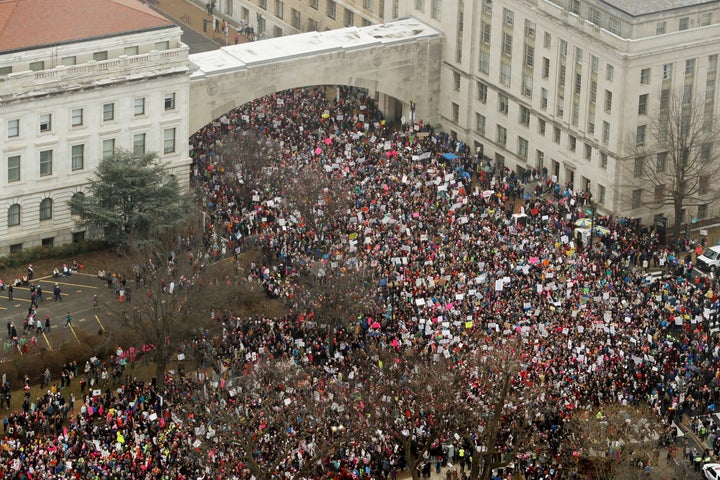
Trump Reset The Clock
The Trump administration spent much of 2017 attempting to overhaul several Obama-era policies and usher in widely challenged changes to immigration, LGBTQ rights and health care.
Days after taking office, Trump installed the first iteration of his travel ban blocking people from seven Muslim-majority nations ― Iran, Iraq, Libya, Somalia, Sudan, Syria and Yemen ― from entering the U.S. The executive order went into effect immediately and resulted in chaos at airports before it was blocked by a federal judge.
When acting Attorney General Sally Yates said the Justice Department would not enforce the ban, Trump fired her.
Trump has since tried to push through two revised versions of the ban ― once in March and again in September ― with adjustments to countries on the list and relaxed restrictions on which travelers are affected. Earlier this month, the third version of the ban was blocked by the U.S. 9th Circuit Court of Appeals.
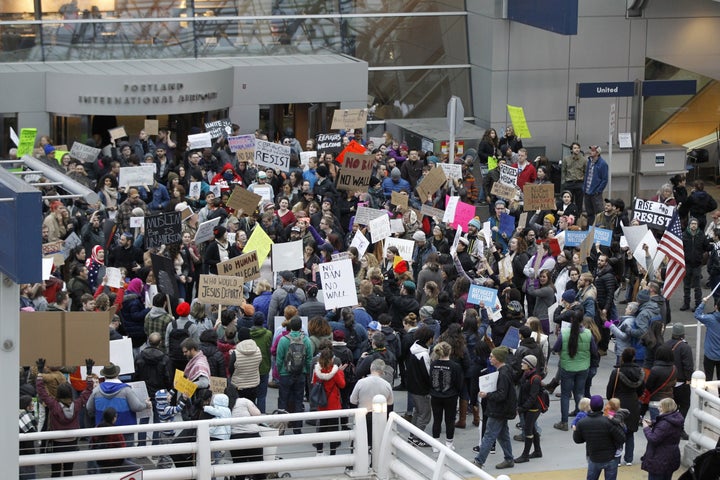
Trump took aim at immigrants again in September when he rescinded Deferred Action for Childhood Arrivals (DACA), the Obama program that allowed some individuals who entered the country as minors to obtain work permits and be protected from deportation. The decision has been met with several legal challenges and a promise from Senate Democrats to fight Trump’s reversal next year.
In July, Trump announced a reversal of the Obama-era decision to repeal the ban on transgender individuals serving in the U.S. armed forces. That executive order was also met with multiple legal challenges and ultimately blocked by multiple judges. Earlier this month, the Department of Justice filed an appeal to that ruling.
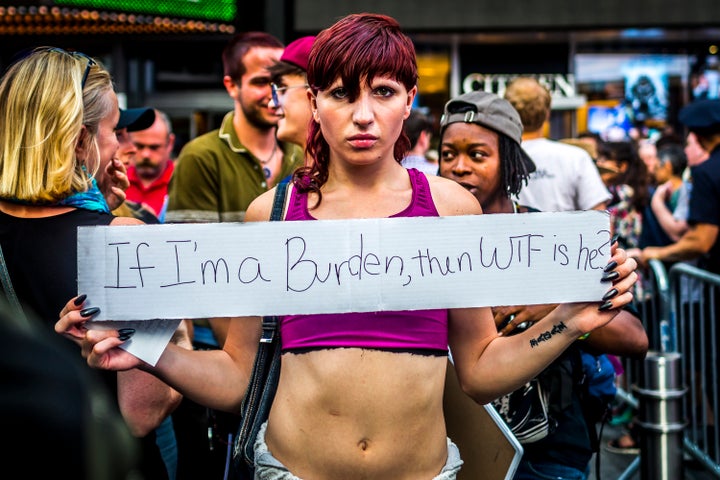
Last week, Trump also claimed that Republicans had “essentially” repealed Obama’s Affordable Care Act through the GOP tax bill. While the tax plan does eliminate the ACA’s individual mandate, it leaves many essential parts in place. Trump’s proclamation comes after Republicans’ several failed attempts to pass legislation overturning the ACA outright.
In the final weeks of the year came the repeal of net neutrality, pushed forward by FCC Commissioner Ajit Pai. The repeal rolls back Obama-era regulations that classified the internet as a public utility and required internet service providers to treat all of the data traveling on their networks equally.
Mother Nature’s Revenge
Mother Nature hit us hard this year. The tail end of summer was marked by devastating natural disasters. In 2017, we had the deadliest, costliest and most active hurricane season on record while also facing record-breaking wildfires in California.

Hurricanes Harvey, Irma and Maria ravaged areas of the United States and the Caribbean in late August and September. Hurricane Harvey brought catastrophic flooding to Houston that destroyed thousands of homes and buildings. Only weeks later, a terrifyingly powerful Hurricane Irma gained power on a course toward St. Martin and Florida. Then Hurricane Maria made landfall in the Caribbean in late September, wiping out parts of Puerto Rico and the U.S. Virgin Islands. Months later, many Puerto Ricans are still without electricity or clean water. The damage to the island’s infrastructure and economy will take years to repair.
Maria tested Trump’s ability to respond to a full-on humanitarian crisis. While he gave himself a 10 out of 10 score on his handling of the situation, critics say that he has not offered enough funding to the island’s rebuilding efforts and that his sparring with local leaders was counterproductive and in poor taste. Also widely considered to be in poor taste? When Trump threw paper towels at struggling Puerto Ricans as if he were lobbing T-shirts from a cannon at a concert.
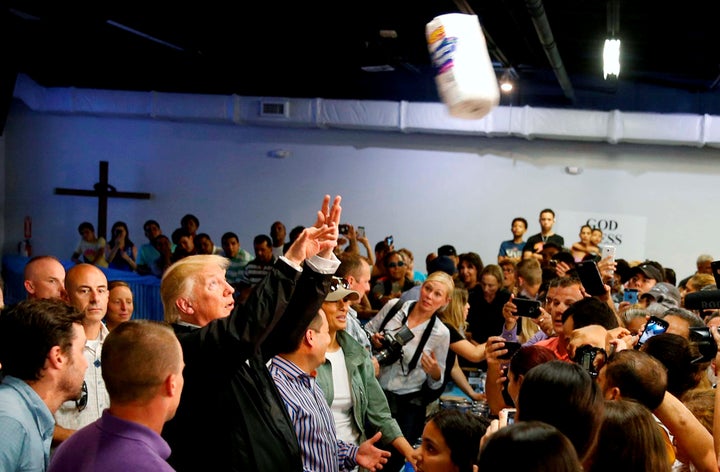
And while all this was happening in the southeastern U.S., wildfires raged in the West. It has been the worst fire year on record for California, with 7,042 fires burning at least 505,930 acres. Thousands of residents have been displaced as their homes and possessions turned to ash.
South of the border, Mexico suffered a 7.1-magnitude earthquake on Sept. 19. Mexican President Enrique Peña Nieto estimated the quake was felt by 50 million people, Reuters reported. The death toll rose to more than 360 after first responders spent days searching through the rubble of about 100 collapsed buildings.
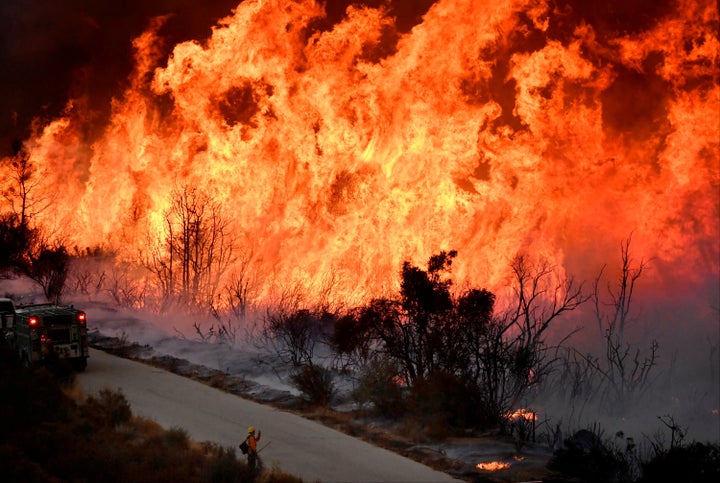
In November, another earthquake struck the Iraq-Iran border and killed more than 400 people in Iran. The magnitude 7.3 quake was the deadliest in the country’s history and also triggered several landslides.
Despite these catastrophes, climate change denial continues to occur in the highest levels of government. Trump pulled the United States out of the Paris Agreement in June, and his leadership on the issue has been a devastating blow to decades of scientific research and global unity on the climate fight.
The White House Revolving Door
Throughout the year, high-ranking officials and members of the president’s inner circle were unceremoniously ousted from or left the White House, while rumors about who’s headed to the exit next continue to spread.
February saw the exit of national security adviser Michael Flynn, who lied about his ties to the Kremlin and his role attempting to ease U.S. sanctions against Russia with its ambassador weeks before Trump took office.
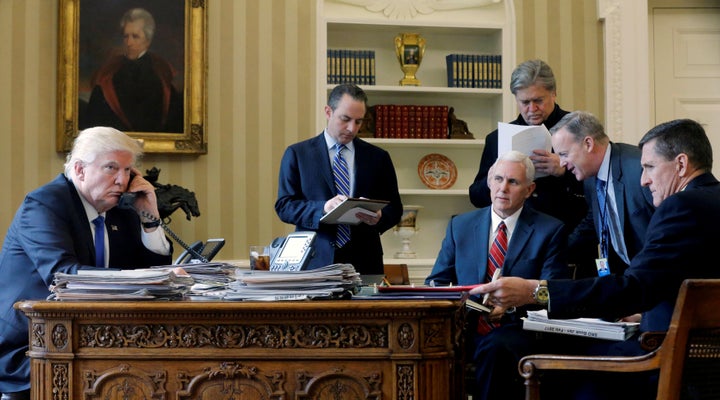
White House press secretary Sean Spicer left his post in July after reportedly objecting to Trump naming Anthony Scaramucci as White House communications director. Spicer had long struggled in the role: His messaging often conflicted with that of Trump, he frequently lashed out at members of the press and he made more than one blunder downplaying the horrors of the Holocaust.
In July, Scaramucci left his job just 10 days into the role after unleashing a profanity-laced tirade against other members of Trump’s staff to a New Yorker reporter. Failing to speak off the record, “The Mooch” called Chief of Staff Reince Priebus a “paranoid schizophrenic, a paranoiac.”
And let’s not forget this gem:
“I’m not Steve Bannon, I’m not trying to suck my own cock,” Scaramucci told The New Yorker. “I’m not trying to build my own brand off the fucking strength of the President. I’m here to serve the country.”
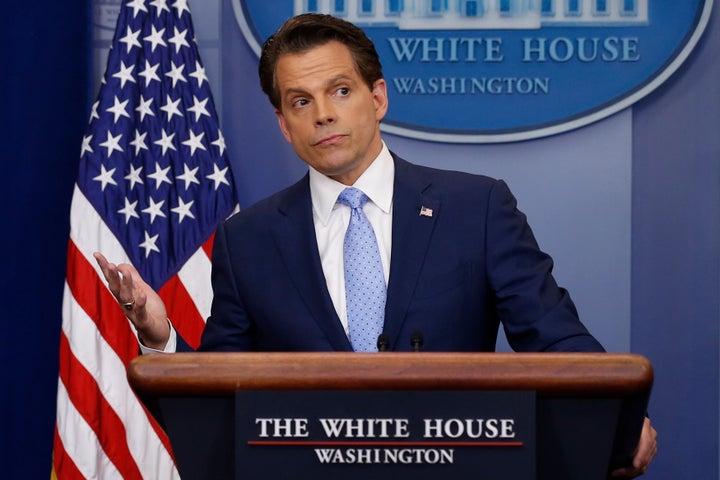
Shortly before Scaramucci’s exit, Priebus also stepped down. The former Republican National Committee chair reportedly clashed with self-described “economic nationalist” and anti-establishmentarian Steve Bannon, whose newly created “chief strategist” position undermined some of Priebus’ authority.
But Bannon wouldn’t last much longer either. The former head of Breitbart News left his role in August. Some linked Bannon’s departure to him being blamed for Trump’s controversial responses to the Charlottesville, Virginia, white supremacy rally. Other sources said Trump fired him because he believed Bannon to be the source of recent leaks to the press.
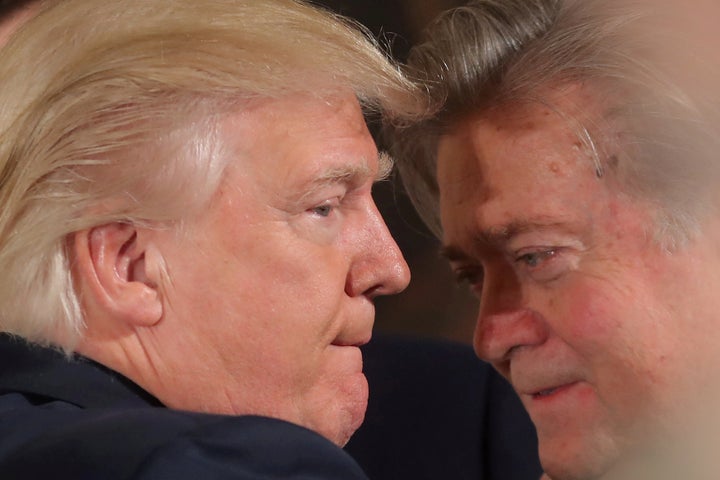
Days later, controversial Trump adviser Sebastian Gorka left his post amid criticism about his ties to far-right foreign political groups and his description of Islam as an inherently violent religion. Although a White House official implied he’d been fired, Gorka issued a resignation letter.
In September, Health and Human Services Secretary Tom Price resigned amid revelations that his frequent use of chartered and military flights cost American taxpayers more than $1 million.
White House aide Omarosa Manigault Newman left her position in mid-December. Newman, who rose to fame on Trump’s reality TV show “The Apprentice,” and White House officials said she resigned, but multiple sources reported that she was fired by Chief of Staff John Kelly, Priebus’s successor.
The Emboldening Of White Nationalists And Racism
This was the year America could no longer deny that its seedy underbelly is full of racists and white supremacists.
Evidently emboldened by the election of a president who has hesitated to disavow their movement and has his own lengthy history of racism, white supremacists and racists made their presence known in 2017 through violent rallies, viral racist rants and the rise of once-fringe figures into White House roles.

Tensions came to a head in August when thousands of torch-wielding white supremacists ― the largest such gathering in more than a decade, according to the Anti-Defamation League ― gathered in Charlottesville, Virginia. One counter-protester, 32-year-old paralegal Heather Heyer, was killed when a white supremacist plowed his car through a crowd.
While the rally was advertised as a protest against the removal of a statue of Confederate Gen. Robert E. Lee, many protesters came with a bigger agenda. “The Jewish media is going down,” “The goyim know” and “We support President Donald Trump” were among their signs.
Backlash to the rally set off a chain reaction. In cities across the U.S., counter-protesters thwarted other white supremacist and so-called “alt-right” events by drowning out their presence with much larger turnouts.
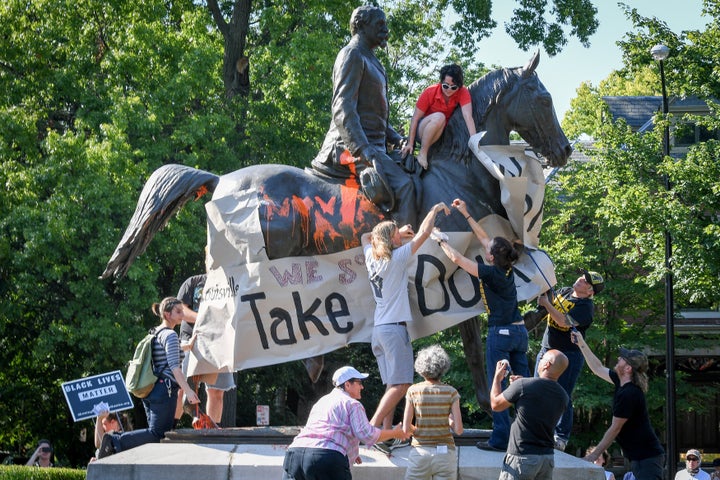
Others responded by demanding that their cities remove statues honoring the Confederacy or, taking matters into their own hands, vandalizing or toppling the monuments.
While addressing the nation after Heyer’s death, the president managed to deepen the nation’s pain by appearing to normalize white nationalists. It took Trump days to condemn the violence rally in Charlottesville, and his address to the country was less than comforting. Trump refused to acknowledge the presence of white nationalists and said there were “very fine people on both sides” in Charlottesville. The statement marked a lack of conviction on Trump’s part to denounce racism.
In September, Trump also stirred racial tensions when he called for fans to boycott National Football League games at which athletes knelt for the national anthem in an ongoing protest against against racial inequality and police brutality. At an Alabama rally that month, Trump implicitly called former San Francisco 49ers quarterback Colin Kaepernick, the athlete who initiated the widespread protests last year, a “son of a bitch.”
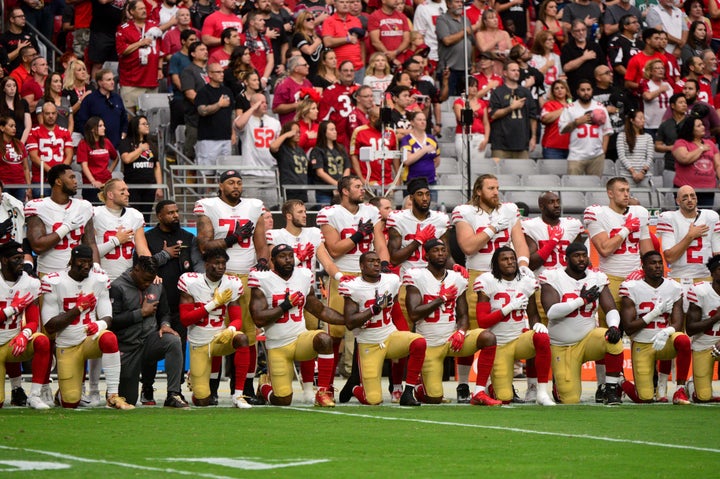
But racism is not just on the rise in the form of large rallies. Individual hate crimes targeting ethnic and religious minorities also are increasing. Data from the Center for the Study of Hate and Extremism at California State University, San Bernardino, found such incidents rose about 5 percent from 2015 to 2016 ― with a dramatic spike during the election period ― and 2017 may prove to be even worse. From January to September, America’s 13 large cities saw, in total, a nearly 20 percent rise in hate crimes compared to the same period in 2016.
You can help HuffPost document hate crimes by clicking here.
We Had The Deadliest Shooting In U.S. History ― Again
For the second year in a row, we saw the deadliest mass shooting in modern U.S. history.
In October, 58 people died and 546 were injured when a lone gunman took aim at crowds enjoying the Route 91 Harvest Festival in Las Vegas. It surpassed the death toll of the shooting at Orlando’s Pulse Nightclub a year earlier, when a gunman claimed 49 lives and injured 58 others.
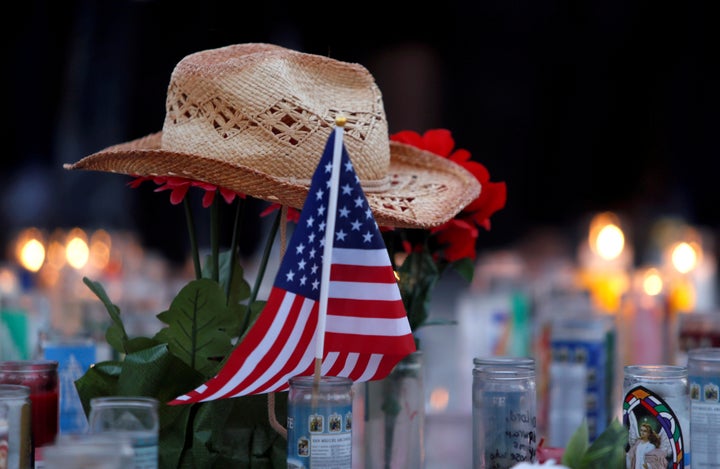
The horror of a new mass shooting record being set so quickly reflects the frightening reality that mass shootings are becoming both more common and more deadly. The October massacre was one of more than 330 mass shootings ― defined as incidents in which four or more people are wounded or killed ― tracked this year by the nonprofit Gun Violence Archive.
Just over a month after the Las Vegas shooting, a gunman walked into a Sutherland Springs, Texas, church and killed 26 congregants and injured 20 others. The massacre knocked the 1999 Columbine High School shooting in Colorado ― an event so shocking at the time it seemed inconceivable it could be overshadowed ― off the list of top 10 deadliest mass shootings in recent U.S. history.
Russia, Russia, Russia
The questions over how Russia meddled in the 2016 election, whether the Trump campaign was aware of it and whether it did anything to cover it up lingered into 2017.
Rather than helping investigators get to the bottom of the issue, Trump has continually discredited the institutions investigating the subject and has not taken any action to ensure meddling won’t happen in the 2018 midterm elections.
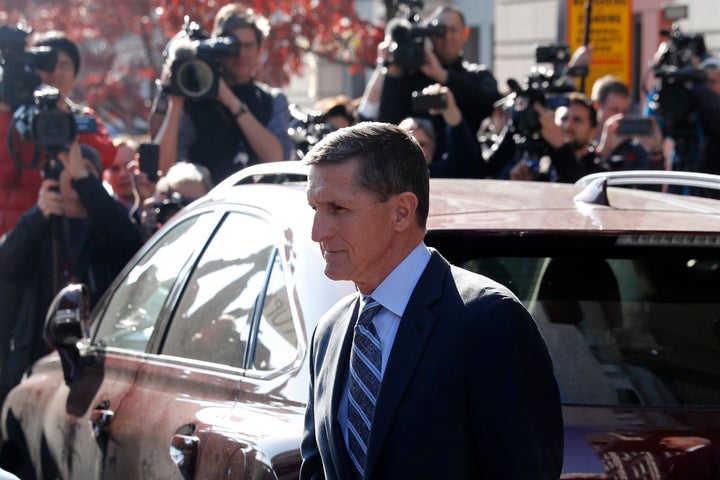
There are multiple investigations into Russia’s involvement, but the one to watch in 2018 is being carried out by special counsel Robert Mueller, who was brought on to conduct the independent probe after Trump fired FBI Director James Comey.
So far, Mueller’s investigation has resulted in indictments of former Trump campaign chairman Paul Manafort, his former aide Rick Gates and Flynn, who pleaded guilty earlier this month to lying to the FBI about his contacts with the Russian government.
Foreign Agitations
Throughout the year, Trump managed to upset several world leaders. Over the course of just a few days in late January and early February, the president picked fights with leaders from Australia, Mexico and Iran. He also reportedly enraged European allies at a spring NATO summit with his flippant attitude toward the Paris climate accord and refusal to reaffirm commitments to key NATO pacts.
But the worst beef Trump ramped up was with North Korea. As the isolated country has accelerated its nuclear weapon and missile development programs, Trump has escalated his threatening rhetoric toward leader Kim Jong Un, promising “fire and fury” if the nation continues with its nuclear ambitions.
North Korea responded by threatening to fire missiles at the U.S. territory of Guam, bringing the U.S. closer to a nuclear standoff than it has been in decades.
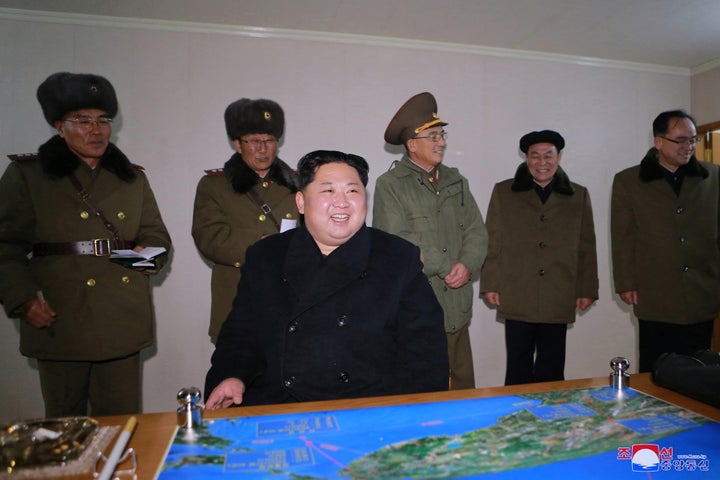
In April, the U.S. conducted its first military strike against the Syrian government, in retaliation for a deadly chemical weapon attack on an opposition-held area. The attack was allegedly carried out by Syrian President Bashar Assad’s regime.
Trump also stoked international tensions in December when he officially recognized Jerusalem as Israel’s capital and directed the State Department to move the U.S. Embassy in Israel there from Tel Aviv. The move threatens to further inflame the strained relationship between Israel and the Palestinians, which both lay claim to Jerusalem.
The one laughable moment? Trump became a meme on his trip to the Middle East when he stood before a mysterious glowing orb with King Salman in Saudi Arabia.
You Didn’t Even Hear About These Stories, Did You?
One of the unfortunate side effects of all the upheaval wrought by the Trump administration is that attention has been sucked away from important global stories while we were lost in the circus of “covfefe” in a Trump tweet and the shock of seemingly never-ending national tragedies.
Yemen has suffered under the weight of Saudi Arabian intervention and a conflict that is starving families across the country. An average of 100 civilians a month are killed in Yemen, mostly from Saudi-led airstrikes and shelling, the United Nation estimates. The World Health Organization estimates 2,219 have been killed in the cholera outbreak, where the suspected amount of infections has hit 1 million cases. And Saudi Arabia announced the closure of ports in Yemen in November that would put nearly 7 million civilians at risk of starvation.
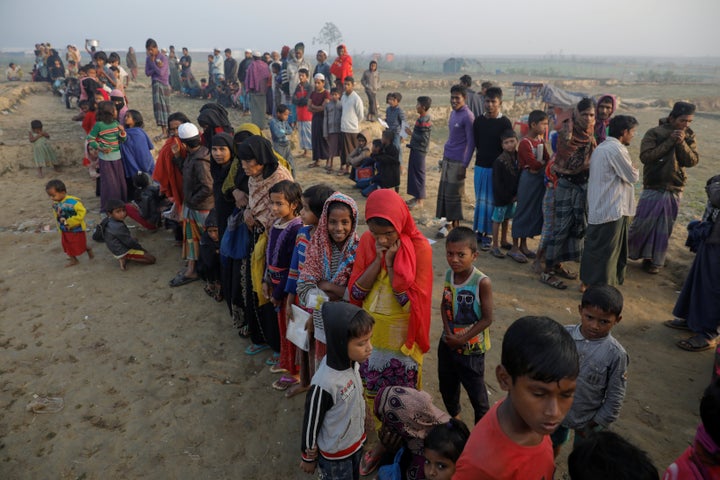
The Trump administration has embraced Saudi Arabia as an ally and pointed to U.S. arms sales to the nation as an American job-creator.
Meanwhile in Myanmar’s Rakhine State, violent state-sanctioned persecution in the last four months of the year has driven more than 655,000 Rohingya Muslims from the region. By Sept. 24, the crisis had claimed at least 9,000 Rohingyas’ lives, humanitarian groups reported.
